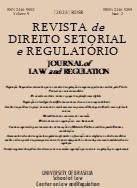Direito de marca e regulação: o caso Louboutin
Keywords:
Louboutin case. Regulatory law. Trademark law. INPI. State intervention.Abstract
The aim of this article is to analyze the Louboutin case from the perspective of regulatory law. Utilizing Herbert Hart's legal positivism as the methodological approach and employing the deductive method as the procedural methodology, the interactions between trademark law and regulatory law are explored. This research is based on two qualitative research modalities: primarily, a literature review, and secondly, a case study focused on the registration procedure of Louboutin's position mark at INPI (Brazil's National Institute of Industrial Property). The results highlight the significance of analyzing trademark law through the lens of regulatory law, with particular emphasis on the role of INPI. The research contributes to filling a literature gap by examining the Louboutin case from a regulatory perspective and underscores the importance of considering state intervention in the market through trademark law at both legal and infralegal levels, particularly in peripheral countries like Brazil.
Downloads
References
ARANDA, Cassidy. The Worldwide Trademark Battle over the Iconic Red Buttom Shoe. Chicago-Kent Journal of Intellectual Property. Chicago. 23 jun. 2023. Disponível em: < https://studentorgs.kentlaw.iit.edu/ckjip/the-worldwide-trademark-battle-over-the-iconic-red-bottom-shoe/>. Acesso em: 28 jun. 2023.
AUSTIN, Greame W. Tolerating confusion about confusion: trademark policies and fair use. In. DINWOODIE, Graeme B.; JANIS, Mark D. Trademark Law and Theory. Cheltenham: Edward Elgar Publishing, 2008.
BAIOCCHI, Enzo. Marca de posição é finalmente regulada pelo INPI. Migalhas. Ribeirão Preto, 19 out. 2021. Disponível em: < https://www.migalhas.com.br/depeso/353255/marca-de-posicao-e-finalmente-regulada-pelo-inpi>. Acesso em: 28 jun. 2023.
BENTLY, Lionel. From communication to thing: historical aspects of the conceptualization of trade marks as property. In. DINWOODIE, Graeme B.; JANIS, Mark D. Trademark Law and Theory. Cheltenham: Edward Elgar Publishing, 2008.
BRASIL. Superior Tribunal de Justiça. Terceira Turma. Recurso especial 1.677.787/SC. Rel. Min. Nancy Andrighi. Jul. 26/9/2017. DJe 2/10/2017.
CASTRO, Beatriz Vergaça. Sinais distintivos não tradicionais: o caso Louboutin. Rio de Janeiro: UFRJ, 2016. Disponível em: < http://www.abapi.org.br/abapi2014/pdfs/monografias/Monografia%20Beatriz%20Castro.pdf>. Acesso em: 28 jun. 2023.
CASTRO, Henrique Porto de; COSTA-NETO, João. Os mitos do positivismo jurídico. Revista Thesis Juris. Vol. 12. No. 1. 2023. Disponível em: < https://periodicos.uninove.br/thesisjuris/article/view/22522>. Acesso em: 28 jun. 2023.
CESÁRIO, Kone. Louboutin deve finalmente ter a sua marca de posição concedida pelo INPI. Jornal Jurid. 19 out. 2021. Disnponível em: < https://www.jornaljurid.com.br/noticias/louboutin-deve-ter-finalmente-a-sua-marca-de-posicao-concedida-pelo-inpi>. Acesso em: 28 jun. 2023.
Christian Louboutin S.A. v. Yves Saint Laurent Am. Holdings, Inc., 696 F.3d 206 (2d Cir. 2012).
CNI. CNI apoia autonomia financeira do Instituto Nacional de Propriedade Industrial. Disponível em: <https://static.poder360.com.br/2023/05/CNI-apoia-autonomia-financeira-do-Instituto-Nacional-de-Propriedade-Industrial.pdf>. Acesso em: 28 jun. 2023.
DUARTE, Melissa F.; BRAGA, Prestes C. Propriedade intelectual. Porto Alegra: SAGAH, 2018.
ERBER, Fabio Stefano. A propriedade industrial como instrumento de competição entre empresas e objeto de política estatal: uma introdução. Pesquisa e planejamento econômico. Vol. 12(3). 1982.
FRANKLYN, David J. Debunking Dilution Doctrine: Toward a Coherent Theory of the Anti-Free-Rider Principle in American Trademark Law. Hastings Law Journal. Vol. 56. No. 117 e 118. 2004.
GRAU, Eros. A ordem econômica na Constituição de 1988 (interpretação e crítica). 15. ed. São Paulo: Malheiros, 2012.
HART, Herbert L. A. The Concept of Law. 3. ed. Oxford: Oxford University Press, 2012.
KRATZKE, William P. Normative Economic Analysis of Trademark Law. Memphis State University Law Review. Vol. 21. No. 199. 1991.
LEMLEY, Mark A. Property, Intellectual Property and Free
Riding. Texas Law Review. Vol. 83. No. 1031. 2005.
MOREIRA NETO, Diogo de Figueiredo. Direito Regulatório. Rio de Janeiro: Renovar, 2003.
PODER 360. CNI pede que instituto de propriedade industrial vire agência. Poder 360. Brasília. 17 mai. 2023. Disponível em: <https://www.poder360.com.br/economia/cni-pede-que-instituto-de-produtividade-industrial-vire-agencia/>. Acesso em: 28 jun. 2023.
REDECKER, Ana Cláudia; MAGNANTI, Isabela. O direito de propriedade intelectual e o trade dress na indústria da moda: um estudo do caso Louboutin. RJLB. Ano 8, No. 3. 2022.
ROSE, Carol M. Crystals and Mud in Property Law. Stanford Law Review. Vol. 40. No. 577 e 578. 1988.
SENFTLEBEN, Martin. Signs Eligible for Trademark Protection in the European Union – Dysfunctional Incentives and a Functionality Dilemma. In. CALBOLI, Irene; GISNBERG, C. (eds.) Cambridge Handbook on International Comparative Trademark Law. Cambridge: Cambridge University Press, 2020.
TAVARES, André Ramos. A Intervenção do Estado no Domínio Econômico. In. CARDOZO, José Eduardo Martins. Curso de Direito Administrativo Econômico. V. II. São Paulo: Malheiros, 2006.
VICENTE, Dário M. A Tutela Internacional da Propriedade Intelectual. Coimbra: Grupo Almedina, 2020.
Downloads
Published
How to Cite
Issue
Section
License
Copyright (c) 2023 Journal of Law and Regulation

This work is licensed under a Creative Commons Attribution 4.0 International License.
By submitting this paper to the Journal of Law and Regulation, I hereby declare that I agree to the terms of the Creative Commons Attribution 4.0 International (CC BY 4.0), available at http://creativecommons.org/licenses/by/4.0.


